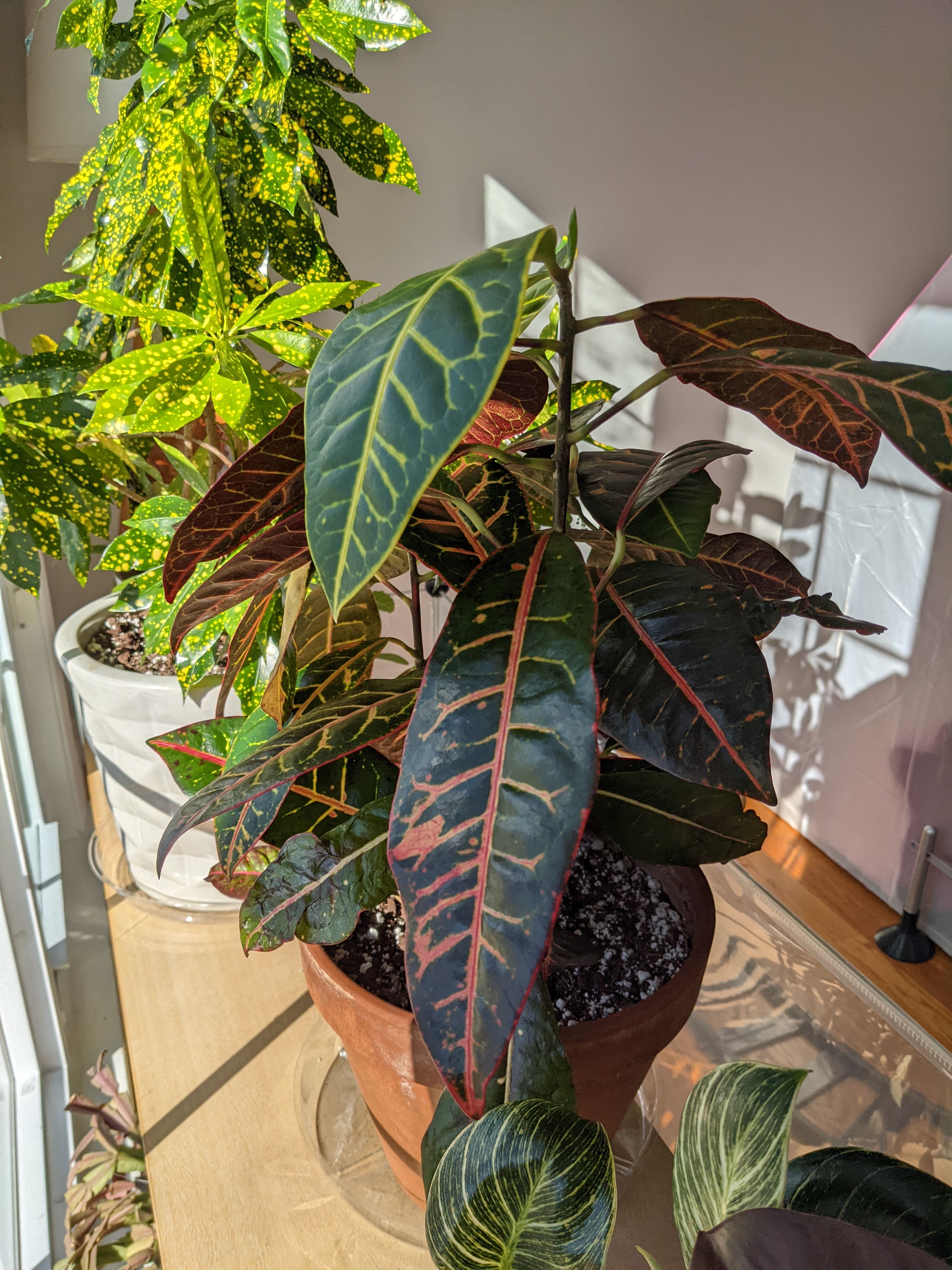Croton Petra is a striking houseplant prized for its colorful, variegated foliage. Native to Southeast Asia, Croton Petra can add a pop of color and tropical charm to your indoor space. Crotons are known to be a bit dramatic so it’s essential to provide the right care, including proper watering, lighting, soil, and fertilizer to keep it happy and healthy. In this guide, I will discuss each aspect of caring for a Croton Petra.
Croton Petra Quick Guide
| Light Needs | Watering Needs | Soil Needs | Fertilizing Needs |
| Bright indirect light. | The top inch of soil should be dry before watering. | Well draining potting soil. | Every 4- 6 weeks during the growing season. |
Watering Needs
Watering is a critical aspect of Croton Petra care. In fact, if you’re having problems with your Croton, this is the most likely culprit.
Moisture
Croton Petras prefer to have their soil kept evenly moist, but not waterlogged. You should water when the top inch of the soil feels dry to the touch. Keeping the soil moist but not too moist can be tricky. You should be cautious not to overwater, as this can lead to root rot. Overwatering can also come about when the pot does not have proper drainage holes. Excess water should be able to escape through the pot to prevent the roots from staying soggy.
Crotons that are underwatered will typically show visible signs pretty quickly. If your Croton’s leaves are drooping, you should check the soil moisture immediately. (See the picture below for an example of drooping from underwatering.) If it’s dry, you should water your Croton and the leaves will miraculously perk up within an hour. To most accurately monitor your Croton’s soil moisture, I recommend a cheap soil moisture meter. I’ve had the same one for years and it’s easily my most used plant tool.

The Right Water
Croton Petras can be sensitive to chemicals and salts in tap water. To prevent the adverse symptoms such as leaf browning and other damage, use distilled water. You can also allow tap water to sit out for about 24 hours to let some of the chemicals evaporate.
Light Needs
Proper lighting is essential for the growth and vibrant leaf colors of the Croton Petra. They thrive in bright, indirect sunlight. Avoid bright direct sun exposure, which can sunburn your Croton’s leaves. An ideal spot is near a window, if it’s a window with strong light you may need sheer curtains. A lack of adequate light, the most common light problem you’ll have with indoor Crotons, will result in the leaves being spaced out and being mostly green. Don’t fret if you see that your new leaves are developing as mostly green. The Croton’s leaves are often green to start but later develop color as they fully form.
To encourage even growth and prevent your Croton from leaning towards the light, it’s a good idea to rotate your Croton Petra a quarter turn every few weeks.
Soil Needs
Crotons don’t require a special soil formula, but they do like soil that stays evenly moist. Peat and other organic matter typically hold moisture in soil mixes. This needs to be balanced with some elements that encourages drainage, such as perlite or vermiculite. Generally, an all-purpose potting soil will do fine, or one geared toward tropical plants will work as well.
Croton Petras are not the fastest growers. They generally only require repotting every 2-3 years when the roots become cramped in the pot. By this point, the soil may be lacking nutrients as well, so the soil refresh will invigorate your Croton. It’s not a must but waiting for Spring to repot is ideal because you’ll be promoting new growth right at the start of the growing season.
Fertilizer Needs
Proper fertilization ensures your Croton Petra has the nutrients it needs to maintain its colorful leaves. Indoor Crotons have pretty straightforward needs. Apply a balanced, water-soluble fertilizer with equal parts of nitrogen, phosphorus, and potassium (or an n-p-k of 10-10-10 for example) during the growing season every 4-6 weeks. The growing season is Spring to early Fall. Do not fertilize your Croton during the Winter. It’s not good to promote growth when light is scarce. You’ll end up with stretched out growth and lack of leaf color if you do.
I strongly recommend that you read and follow the fertilizer’s instructions. Many fertilizers call for dilution. This is important because a symptom of over-fertilizing is slow growth. And some people misinterpret slow growth as their plant needing more fertilizer, which obviously makes the problem worse.
Common Issues
Here are a few common problems people experience with Croton Petras.
Leaf Drop
If your Croton Petra is shedding leaves, it’s most likely due to watering issues. Some leaf drop is normal, for example if one or two leaves at the base of the stem drop, that’s probably due to older leaves dying off. However, if you suspect something different, check out my post on Croton Leaf Drop.
Pests
Keep an eye out for common houseplant pests like spider mites and mealybugs. I have unfortunately battled spider mites on my own Croton Petra. Read about the battle here.
Yellowing leaves
Yellow leaves may be a sign of overwatering or poor drainage. Check your Croton’s soil moisture if you see yellow leaves. Just as I stated earlier though, some amount of yellowing leaves and leaf drop is normal. Especially for older leaves toward the base of the trunk.
Do you have addition questions about caring for Crotons? Put them in the Comments section.

I'm a long time plant lover on the quest to happily coexist with as many plants as I can. Let's grow!
